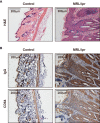Amelioration of Lupus Serum-Induced Skin Inflammation in CD64-Deficient Mice
- PMID: 35273604
- PMCID: PMC8901504
- DOI: 10.3389/fimmu.2022.824008
Amelioration of Lupus Serum-Induced Skin Inflammation in CD64-Deficient Mice
Abstract
Systemic lupus erythematosus (SLE) is a heterogeneous autoimmune disorder characterized by high autoantibodies levels and multiorgan tissue damage. The current study investigated the role of CD64 in SLE patients and animal models. According to a flow cytometry study, SLE patients showed an increase in CD64 expression in circulating monocytes. There was a correlation between CD64 and SLEDAI, blood urea nitrogen levels, and anti-Sm antibodies. In skin lesions of lupus MRL/lpr mice, there was high IgG deposition and CD64 expression. In vitro, cytokines IL-10 and IFN-γ upregulated CD64 expression in monocytes/macrophages that was inhibited by glucocorticoids. In CD64-deficient mice, skin inflammation induced by lupus serum was reduced. Furthermore, activation of spleen tyrosine kinase (Syk), Akt, and extracellular signal-regulated kinase (Erk) was inhibited in CD64-deficient monocytes. The results suggest that CD64 could be a biomarker for observing SLE progression, as well as a mechanistic checkpoint in lupus pathogenesis.
Keywords: CD64; flow cytometry; inflammation; monocytes/macrophages; systemic lupus erythematosus.
Copyright © 2022 Jiang, Han, Qiu, Yu, Feng, Wang, Duan and Deng.
Conflict of interest statement
The authors declare that the research was conducted in the absence of any commercial or financial relationships that could be construed as a potential conflict of interest.
Figures






Similar articles
-
The role of organ-deposited IgG in the pathogenesis of multi-organ and tissue damage in systemic lupus erythematosus.Front Immunol. 2022 Oct 13;13:924766. doi: 10.3389/fimmu.2022.924766. eCollection 2022. Front Immunol. 2022. PMID: 36311714 Free PMC article. Review.
-
Expression of CD64 on Surface of Circulating Monocytes in Systemic Lupus Erythematosus Patients: Relation to Disease Activity and Lupus Nephritis.Egypt J Immunol. 2017 Jan;24(1):67-78. Egypt J Immunol. 2017. PMID: 29120579
-
Monocyte surface expression of Fcgamma receptor RI (CD64), a biomarker reflecting type-I interferon levels in systemic lupus erythematosus.Arthritis Res Ther. 2010;12(3):R90. doi: 10.1186/ar3017. Epub 2010 May 18. Arthritis Res Ther. 2010. PMID: 20478071 Free PMC article.
-
Increased expression of FcgammaRI/CD64 on circulating monocytes parallels ongoing inflammation and nephritis in lupus.Arthritis Res Ther. 2009;11(1):R6. doi: 10.1186/ar2590. Epub 2009 Jan 14. Arthritis Res Ther. 2009. PMID: 19144150 Free PMC article.
-
Animal models of studying the pathogenesis of multi-organ tissue damage in lupus.Clin Immunol. 2024 Jun;263:110231. doi: 10.1016/j.clim.2024.110231. Epub 2024 Apr 29. Clin Immunol. 2024. PMID: 38692449 Review.
Cited by
-
The role of organ-deposited IgG in the pathogenesis of multi-organ and tissue damage in systemic lupus erythematosus.Front Immunol. 2022 Oct 13;13:924766. doi: 10.3389/fimmu.2022.924766. eCollection 2022. Front Immunol. 2022. PMID: 36311714 Free PMC article. Review.
-
Immunoglobulin G inhibits glucocorticoid-induced osteoporosis through occupation of FcγRI.iScience. 2023 Aug 26;26(10):107749. doi: 10.1016/j.isci.2023.107749. eCollection 2023 Oct 20. iScience. 2023. PMID: 37701568 Free PMC article.
-
CD64 plays a key role in diabetic wound healing.Front Immunol. 2024 Mar 8;15:1322256. doi: 10.3389/fimmu.2024.1322256. eCollection 2024. Front Immunol. 2024. PMID: 38524127 Free PMC article.
-
Recent Advances of Type I Interferon on the Regulation of Immune Cells and the Treatment of Systemic Lupus Erythematosus.J Inflamm Res. 2025 Mar 30;18:4533-4549. doi: 10.2147/JIR.S516195. eCollection 2025. J Inflamm Res. 2025. PMID: 40182060 Free PMC article. Review.
-
Inhibitory effect of hydroxychloroquine on glucocorticoid-induced osteoporosis in lupus therapy.Clin Transl Immunology. 2024 Oct 14;13(10):e70010. doi: 10.1002/cti2.70010. eCollection 2024. Clin Transl Immunology. 2024. PMID: 39416769 Free PMC article.
References
Publication types
MeSH terms
Substances
LinkOut - more resources
Full Text Sources
Medical
Molecular Biology Databases
Miscellaneous

